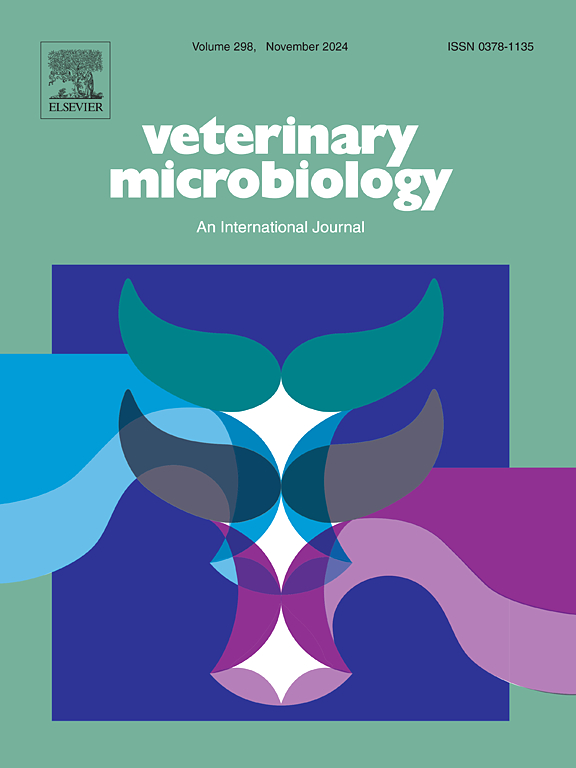用于研究牛支原体呼吸道感染的牛气管器官组织。
IF 2.4
2区 农林科学
Q3 MICROBIOLOGY
引用次数: 0
摘要
体外三维类器官模型模拟了体内器官结构和功能的关键方面,已被用于研究生理学、宿主-病原体相互作用、致病机理和药效学。虽然大多数类器官研究都是利用人体或小鼠组织开发的,但最近的研究进展已使利用家畜样本建立肠道和呼吸道类器官成为可能。牛支原体会导致牛慢性呼吸道感染,对健康和经济造成重大影响。牛支原体的致病机理和毒力因子已在多个体外感染模型中进行了研究,但此前还未对有机体的使用进行过研究。在本研究中,我们评估了使用基质包埋的牛气管类器官系统研究牛海绵状芽孢杆菌呼吸道感染的可行性。牛气管类器官接种牛杆菌菌株 MbovMil 并培养 72 小时,以研究牛杆菌增殖、附着和侵入类器官的能力。牛海绵状芽孢杆菌能够感染器官组织,接种后 72 小时,存活的牛海绵状芽孢杆菌滴度平均增加了 260 倍。使用透射电子显微镜对受感染的类器官进行检查后发现,类器官细胞内存在支原体,细胞间连接处存在与膜结合的牛曲霉菌团。我们的研究结果表明,牛气管类器官可用作研究牛海绵状芽孢杆菌引起的呼吸道感染的模型系统。本文章由计算机程序翻译,如有差异,请以英文原文为准。
Bovine tracheal organoids for studying Mycoplasma bovis respiratory infections
In vitro three-dimensional organoid models simulate key aspects of the structure and function of in vivo organs and have been used to study physiology, host-pathogen interactions, pathogenesis and pharmacodynamics. Although most organoid studies have been developed using human or mouse tissues, recent advancements have enabled the establishment of intestinal and respiratory tract organoids from domestic animal samples. Mycoplasma bovis causes chronic respiratory tract infections in cattle with significant health and economic consequences. The pathogenesis and virulence factors of M. bovis have been studied in several in vitro infection models, but the use of organoids has not been examined previously. In this study, we assessed the feasibility of using a matrix-embedded bovine tracheal organoid system to study respiratory infections with M. bovis. Bovine tracheal organoids were inoculated with M. bovis strain MbovMil and incubated for 72 hours to investigate the ability of M. bovis to proliferate, attach and invade the organoids. M. bovis was able to infect the organoids, resulting in a mean 260-fold increase in the titre of viable M. bovis by 72 hours post-inoculation. Examination of the infected organoids using transmission electron microscopy revealed the presence of mycoplasmas within the organoid cells and membrane bound clusters of M. bovis inside the intercellular junctions. Our findings indicate that bovine tracheal organoids can be used as a model system for studying respiratory tract infections caused by M. bovis.
求助全文
通过发布文献求助,成功后即可免费获取论文全文。
去求助
来源期刊

Veterinary microbiology
农林科学-兽医学
CiteScore
5.90
自引率
6.10%
发文量
221
审稿时长
52 days
期刊介绍:
Veterinary Microbiology is concerned with microbial (bacterial, fungal, viral) diseases of domesticated vertebrate animals (livestock, companion animals, fur-bearing animals, game, poultry, fish) that supply food, other useful products or companionship. In addition, Microbial diseases of wild animals living in captivity, or as members of the feral fauna will also be considered if the infections are of interest because of their interrelation with humans (zoonoses) and/or domestic animals. Studies of antimicrobial resistance are also included, provided that the results represent a substantial advance in knowledge. Authors are strongly encouraged to read - prior to submission - the Editorials (''Scope or cope'' and ''Scope or cope II'') published previously in the journal. The Editors reserve the right to suggest submission to another journal for those papers which they feel would be more appropriate for consideration by that journal.
Original research papers of high quality and novelty on aspects of control, host response, molecular biology, pathogenesis, prevention, and treatment of microbial diseases of animals are published. Papers dealing primarily with immunology, epidemiology, molecular biology and antiviral or microbial agents will only be considered if they demonstrate a clear impact on a disease. Papers focusing solely on diagnostic techniques (such as another PCR protocol or ELISA) will not be published - focus should be on a microorganism and not on a particular technique. Papers only reporting microbial sequences, transcriptomics data, or proteomics data will not be considered unless the results represent a substantial advance in knowledge.
Drug trial papers will be considered if they have general application or significance. Papers on the identification of microorganisms will also be considered, but detailed taxonomic studies do not fall within the scope of the journal. Case reports will not be published, unless they have general application or contain novel aspects. Papers of geographically limited interest, which repeat what had been established elsewhere will not be considered. The readership of the journal is global.
 求助内容:
求助内容: 应助结果提醒方式:
应助结果提醒方式:


